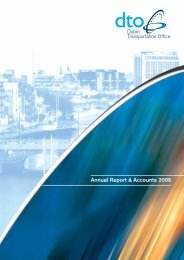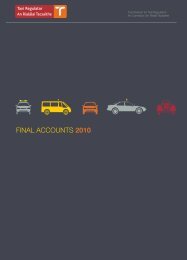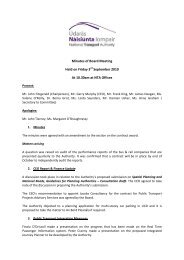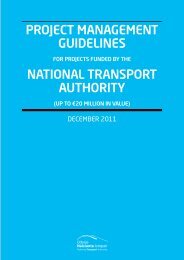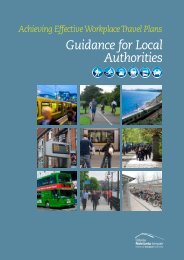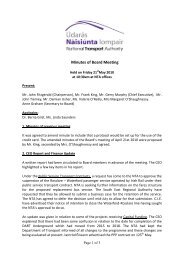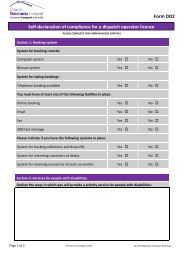Greater Dublin Area Draft Transport Strategy 2011-2030
Greater Dublin Area Draft Transport Strategy 2011-2030
Greater Dublin Area Draft Transport Strategy 2011-2030
- No tags were found...
Create successful ePaper yourself
Turn your PDF publications into a flip-book with our unique Google optimized e-Paper software.
No. Sub-objective <strong>Strategy</strong>score3.3 Minimisephysicalintrusionof motortrafficMeasures which supportthe sub-objectiveROAD8FRT3TDM1TDM2Management of parking,waiting & loadingPlanning for Distributionand ServicingTraffic control measuresParking charges andleviesPredicted outcomes by<strong>2030</strong> from <strong>Strategy</strong> (basedon 3-hour AM peak modeloutputs)Benefits from restrictingaccess for some cars lowerspeeds and limiting allHGVs in urban areas will becomplemented by bettermanagement of the on-streetvisibility of public transport.The <strong>Strategy</strong> includes measures that generallyenhance the urban environment, includingimproving and maintaining the streetscape, betterdesign of residential streets to assist pedestrianand cyclist movement, and other measuresproviding priority for pedestrians and vulnerableusers in towns and <strong>Dublin</strong> city centre.These will need to be closely linked withdevelopment planning, to ensure that high-qualitystreetscapes and permeable access is provided innew developments; as well as other enhancementsto the urban public realm.Planning measures will be needed to promote thepositive aspects of transport-related developmentin urban areas and to recognise and mitigate thepotential negative impacts. Measures WCY 8and WCY 17 are designed to take full advantageof this type of opportunity to promote positive,high-quality and attractive walking and cyclingenvironments in urban centres and thesemeasures will result in positive townscape andstreetscape impacts.The <strong>Strategy</strong> includes a significant number ofenhancements to public transport vehicles, aswell as good quality on-street infrastructure forthose waiting for buses, coaches and taxis. Thesemeasures also have the potential to enhancetownscapes – and can result in wider urbanregeneration effects, such as those often associatedwith new light rail lines and high quality transportinterchanges and hubs.Some more detailed assessment of the vehicleflows along corridors has been undertaken forStrategic Environmental reporting of noise levels,and initial analysis shows the <strong>Strategy</strong> will havea significant positive impact on reducing physicalintrusion of traffic in many areas where peoplecirculate, reinforcing the usability of streets andenhancing access by walking and cycling to keyfacilities (though this is not all directly captured inthe modelling).Alongside this, greater attention to maintenancewill be needed to avoid the deterioration of suchfacilities – and the streetscape itself – over time. Itis clearly enshrined in the overall <strong>Strategy</strong> approachthat quality must be not only designed and built inwhere investment takes place, but also maintained.Management of the competing uses of streetswill be important, alongside design and newinvestment, in delivering and maintaining moreusable and people-friendly streetsOverall, the <strong>Strategy</strong> is considered to perform wellagainst this objective.Chapter 12: page 19 www.<strong>2030</strong>vision.ie




